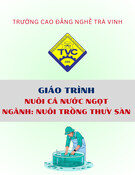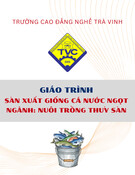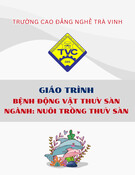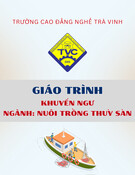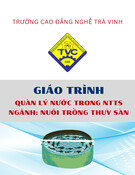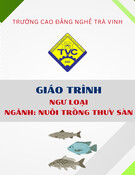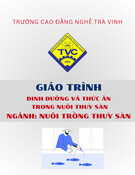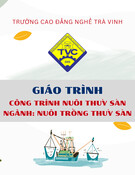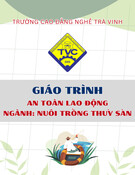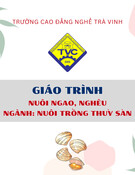
Vietnam Journal
of Agricultural
Sciences
ISSN 2588-1299
VJAS 2022; 5(4): 1674-1689
https://doi.org/10.31817/vjas.2022.5.4.06
https://vjas.vnua.edu.vn/
1674
Received: May 14, 2022
Accepted: October 28, 2022
ORCID
Nguyen Thi Hai Ninh
https://orcid.org/0000-0003-0262-
9681
Correspondence to
nthaininh@vnua.edu.vn
Measures Used for Water Quality
Management in Intensive Pangasius Catfish
Production in Vietnam’s Mekong Delta:
Experiences from Household Practices and
Gender Roles
Nguyen Thi Hai Ninh* & Ho Ngoc Cuong
Faculty of Economics and Rural Development, Vietnam University of Agriculture, Hanoi
131000, Vietnam
Abstract
Intensive aquaculture on a household-scale in Vietnam’s Mekong
Delta region often decreases the quality of the water. The
consequences are a negative effect on the yield of Pangasius catfish,
which in turn reduces the income generation potential. Water quality
management has become an important consideration, not only for
sustaining livelihoods from household-scale aquaculture but also for
mitigating the impacts on the surrounding water bodies. The purposes
of this paper are to identify strategies for improving water quality
management in households practicing aquaculture and to understand
the role gender plays in water management in the Mekong Delta. The
effectiveness of existing household approaches to water quality
management was found through analyzing data gathered through
interviews. The primary data consisted of interviews with 32
operators of different household-scale aquaculture systems. It was
found that in 46% of these households, water quality had declined
over the last three years. Several causes were identified including the
accumulation of chemicals and antibiotic residues, excessive
stocking rates, and a lack of a water treatment system. Several
strategies to better manage water quality in these ponds were
identified including changing the clean water more frequently,
removing sediment after each harvest, planting trees around the
ponds, and applying lime to the base of the pond, or using potassium
permanganate for disinfection before use. Although many water
quality management approaches were in use by households, more
than 90% of these activities were implemented by men.
Keywords
Intensive Pagasius catfish, water quality management, household
practice, gender role, Mekong delta

Nguyen Thi Hai Ninh & Ho Ngoc Cuong (2022)
https://vjas.vnua.edu.vn/
1675
Introduction
Aquaculture production of catfish is a
thriving rural industry in the Mekong Delta
region of Vietnam, with an estimated annual
production capacity of around 1.1 million tons
from an area of 5,412ha (DOF, 2019). Intensified
production in pond-based aquaculture systems
for two popular catfish species, namely Tra
(Pangasius hypoththalmus) and Basa (Pangasius
bocourti), has been common at a household level
since 2005. Catfish have been successfully
exported to the European and US markets since
2006 causing a jump in demand for production.
To facilitate growth in the industry to meet the
new global demands, the Vietnamese
government started developing feed-mills and
processing factories in 2007. New breeding and
growing technologies have enabled a shift from
caged-production to intensive production in
ponds. This has allowed for a wider adoption of
aquaculture systems by households in the
Mekong Delta region (Bosma & Verdegem,
2011). These technological developments have
led to a rapid increase in aquaculture production
of Pangasius catfish in a short time frame. While
this has resulted in the consolidation of parts of
the industry, significant levels of production still
occur at a household level (Marschke &
Wilkings, 2014).
Despite a remarkable increase in catfish
production, poor water quality has been stated to
undesirably affect catfish production households,
mostly by affecting fish growth, production,
quality, and profitability (Kirya, 2011). Catfish
production has been reduced by contaminated
waters that impair the development, growth, and
reproduction or even cause mortality to the
cultured fish species (Umesh et al., 2008). As a
consequence, catfish households have been
obliged to manage water quality to provide a
good environment that meets the physical,
chemical, and biological standards for catfish
health and growth (Tumwesigye et al., 2021).
Intensive catfish households apply several
common methods for controlling water quality
such as pond design, fertilization, supplemental
feeding, increased stock density, disease control,
and strategic harvesting. Incorrect execution of
these methods in terms of the product amount
used can cause problems for the farmers and the
surrounding environment. The negative impacts
associated with intensive systems include
nutrient and organic matter enrichment of
wastewater resulting in a build-up of anoxic
sediments, changes to the benthic environment,
and the eutrophication of ponds (Kongkeo,
2001). Practices used in intensive aquaculture of
Pangasius catfish by households in the Mekong
Delta region often result in water culture of low
quality due to the build-up of food, chemicals,
and antibiotics as well as biological excrement
from the fish. This has resulted in negative
impacts on the health of the surrounding
environment, affecting the long-term
sustainability of the industry.
The development of sustainable production
models for aquaculture systems should consider
three main views. Firstly, the amount of land,
water, and energy resources used for production, as
well as water quality and effluent control need to be
considered. From an economic perspective, there
are questions about profitability, market supply and
demand, and feeding efficiency. Finally, a
sociological perspective might examine the
creation of jobs, and the local sourcing of inputs
such as feed, labour, and investments (Wurts,
2007). In the context of the intensive household
production of Pangasius catfish in the Mekong
Delta, efforts to ensure the sustainability of these
systems should focus on water quality monitoring,
the effectiveness of measures to improve water
quality, and the division of labour by gender in
managing water quality.
Women in the Mekong Delta region of
Vietnam play a significant role in aquaculture
production. However, the contributions of women
to household aquaculture production often go
unrecognized and the benefits of their participation
are often not objectively considered in
sustainability assessments (Ahmed et al., 2012).
Because of this, recognizing women’s roles in the
management of water quality in household
Pangasius catfish production has the notable
potential to contribute to more sustainable practices
for aquaculture in the region.

Measures used for water quality management in intensive Pangasius catfish production in Vietnam’s Mekong Delta
1676
Vietnam Journal of Agricultural Sciences
According to the Vietnam Institute of
Aquaculture Economics and Planning,
Pangasius catfish cultured by farm households
accounted for more than 48% of the production
area in the Mekong Delta in the years prior to
2015. However, after 2015, 88% of the
production in the region was consolidated by
large companies, while 12% was cultured at the
household level (Thanh Cong, 2015). The typical
size for an intensive aquaculture pond is 0.4ha.
Less than 10% of producers have more than four
ponds (World Bank, 2010). Households engaged
in producing Pangasius catfish usually apply
various management approaches to improve
water quality. These include the treatment of the
pond base, regular replacement of the water in
the pond, aeration, feed controls, or the chemical
treatment of the water (Vo et al., 2015).
Since early 2015, the total export of catfish
to key markets has declined. For example sales
to the US have declined by 6.3%, while sales to
the EU have declined by 17.2%. This was caused,
in part, by competition from other fish exporting
countries and the comparatively poor quality of
Vietnamese Pangasius species in these markets.
The decrease in demand for Vietnamese cultured
Pangasius and the reputation of inferior quality
resulted in a decline in value for the industry.
This particularly affected the farm households
with the loss of income due to production costs
being higher than the value of the product
(VASEP, 2016). In response, households
attempted to reduce the production costs of
Pangasius by prioritizing the expenditures of
feed and medicines, rather than water quality
treatment. With limited financial resources,
households were primarily concerned with
measures that could improve the economic
output of their aquaculture systems.
This paper addresses the lack of knowledge
about water quality management employed by
household aquaculture systems in the Mekong
Delta. This knowledge is intended to assist local
government officials in increasing their
understanding of issues connected to water
quality management in the Mekong Delta.
Materials and Methods
Research site selection
In the Mekong Delta, Pangasius catfish are
primarily cultured intensively in ponds with
earthen walls, which are situated adjacent to a
river source. This facilitates the exchange of
large volumes of water from these ponds to the
adjacent river (World Bank, 2010). To
investigate the water quality issues that result
from this practice, Can Tho, An Giang, and
Dong Thap provinces were considered because
Pangasius catfish production in these three
provinces accounts for more than 75% of the
total Pangasius production in the country
(DOF, 2019).
Thot Not district in Can Tho province was
later selected as an appropriate study location.
The district has the largest (330ha) intensive
Pangasius catfish area, which accounts for more
than 50% of the catfish production area in Can
Tho province (Can Tho Statistical Year Book,
2019). Thot Not is also located adjacent to the
Hau River, which is a distributary of the Mekong
River. Households practicing aquaculture in this
district have advantages over other areas in terms
of access to water (Figure 1). However, they also
face some difficulties in controlling the quality of
this water, particularly during the wet season.
Data collection
Field survey: As approximately 95% of the
Pangasius catfish produced in the Mekong Delta
are currently cultured in ponds, this research
primarily focused on analyzing household
approaches to water quality management in these
ponds (World Bank, 2010). There were a total of
32 households producing Pangasius catfish
species in Thot Not district. Previously, this
number was much higher, however during the
wet season between October 2018 and April
2019, saline intrusion in the Mekong Delta had
strong impacts on aquaculture production. This
occurred simultaneously with a sharp decline in
the price of catfish, causing many households to
pursue other livelihood sources.
A baseline survey found that the intensive
small-scale production of Pangasius catfish was
having a significant environmental impact.

Nguyen Thi Hai Ninh & Ho Ngoc Cuong (2022)
https://vjas.vnua.edu.vn/
1677
Figure 1. Location of the case study area in Can Tho province
Based on these results, a questionnaire was
developed to gather more detailed information
about the water quality management practices
used by the 32 households culturing catfish in the
province. The questionnaire included the number
of catfish ponds, the area of each pond, catfish
production, catfish price and production costs,
perception of producers about water quality,
methods applied to control water quality, etc. The
questionnaire also included a section on gender
roles in Pangasius catfish production to better
understand the impact gender roles may have on
the sustainability of household aquaculture
systems. This section was designed to allow men
and women to respond separately. Interviews
were conducted over the first two weeks of
December in 2019. Local staff from the Thot Not
district office facilitated access to the households
and two-hour interviews were conducted based
on the questionnaire.
Focus group discussions (FGDs) with key-
informants were used to check the reliability of
information gathered from the questionnaire.
This is a commonly-used method in qualitative
research to collate the individual and collective
understandings of issues experienced by
participants in a case study, as well as gather
further information to answer research questions.
FGDs with women who were members of
households producing Pangasius catfish or who
were hired laborers were conducted to obtain
information about the role of gender in water
quality management in these aquaculture systems.
FGDs were also held with male heads of
households to identify which factors were
affecting water quality management practices in
these households. The FGDs also considered the
barriers to improving water quality management
in the future and their implications.
Key informant interviews were conducted
with participants from the three local government
authorities in Thot Not district to better
understand how the water quality in intensive
aquaculture ponds is monitored, and which
measures are applied to improve water quality.
Data analysis
Primary data were collected and analyzed
using a combination of quantitative and
qualitative methods. Descriptive statistics were
calculated for the absolute number, average
number, and frequency of use of the practical
measures of methods used to manage water
quality in each household. Besides, the Mann-
Whitney U test was used to compare differences
in the role of male and female labor in water
quality management. A qualitative analysis of
the interview data was also completed using data
Hau River

Measures used for water quality management in intensive Pangasius catfish production in Vietnam’s Mekong Delta
1678
Vietnam Journal of Agricultural Sciences
from the FGDs with women to understand
gender roles in household aquaculture systems,
with a specific focus on the management of water
quality.
Results and Discussion
The production of catfish in Thot Not district
Pangasius catfish production using water
sourced from the Hau River in Thot Not district
is concentrated in adjacent communes, such as
Tan Loc, Thuan An, Trung Kien, Thuan Hung,
and Thoi Thuan. Each household was found to
have on average 2.68 ponds (standard deviation
of 1.42), with a surface area of 1.04 ha per pond
(standard deviation of 0.55). In 2019, the annual
average yield from one pond was 233.51 tons. In
2019, households reported that the market price
for Pangasius catfish ranged between 17,000 and
20,000 VND/kg. With this price point, farmers
struggled to cover operating costs and this
resulted in limited expenditures on water quality
management.
Water quality management situation in
aquacultural ponds of Thot Not district
The Fisheries Department of Can Tho City
put into effect regulations that catfish producers
(Guide No. 126/HD CCTS) were required to
build a sediment holding pond to store water
when dredging the culture, rather than
discharging it untreated. This was done to protect
the surrouding rivers and canal systems from
aquacultural waste. The treatment pond was
required to be 15-20% of the area of the
production ponds. However, in practice, only
four households were able to comply with these
regulations. Production costs being higher than
the production yield did not give the profits
required to afford investing in the sediment
holding ponds. This meant that the impact of
water pollution from household aquaculture
systems continued to be an issue.
As no recent assessments of the water
quality of these household systems in Thot Not
district were available from the Fisheries
Department of Can Tho province, domestic
Pangasius catfish producers were asked to
conduct a self-assessment of changes to the water
quality in their aquaculture systems in the past
three years. While the Fisheries Department of
Can Tho province does not require households to
have the water quality of their ponds assessed,
four householders were willing to pay for this
assessment, with a view to improve their
production volumes and the quality of their
product. These assessments were performed by
contracted technicians, employed by
aquacultural companies in the district.
Interviews were also conducted on the
households’ perceptions of changes to their water
quality over the past three years. Almost 47% of
households reported that the water quality in their
systems had declined, 41% believed there had
been no change, and only 12% claimed that the
water quality had improved (Table 1). These
differences in perception were assumed to occur
as household heads have different levels of
experience. On average, each household had
practiced Pangasius catfish production for ten-
years. However, some had fifteen-years of
experience, while others had less than seven.
Table 1. Household self-assessment of the change in water quality compared to three years ago
Type of assessment
Observation
(n = 32)
Percentage
(%)
- Household head self-assessment
28
87.5
- Hired technicians assessment
4
12.5
Change in water quality compared to 3 years ago
- No change
13
40.6
- More pollution
15
46.9
- Less pollution
4
12.5

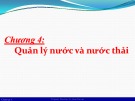
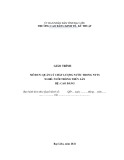

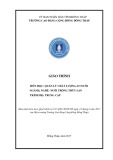

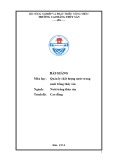
![Đề cương chi tiết: Quản lý chất lượng nước trong nuôi trồng thủy sản [chuẩn nhất]](https://cdn.tailieu.vn/images/document/thumbnail/2020/20201102/larachdumlanat123/135x160/8901604286280.jpg)
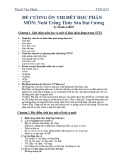
![Bài giảng Quản lý chất lượng nước trong nuôi trồng thủy sản [mới nhất]](https://cdn.tailieu.vn/images/document/thumbnail/2015/20151101/lechaugeo/135x160/3141446395543.jpg)
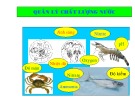
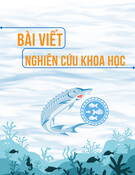
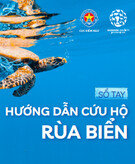
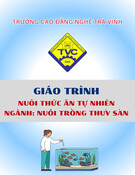
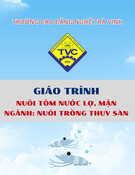
![Giáo trình Sản xuất giống tôm nước lợ, mặn (Trung cấp/Cao đẳng) - Trường Cao đẳng nghề Trà Vinh [Mới nhất]](https://cdn.tailieu.vn/images/document/thumbnail/2025/20251115/kimphuong1001/135x160/76031763179346.jpg)
